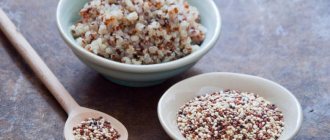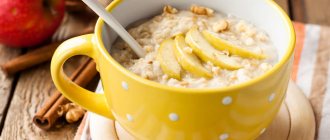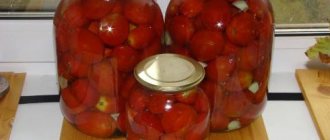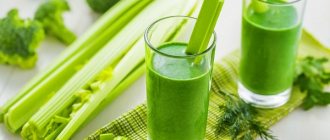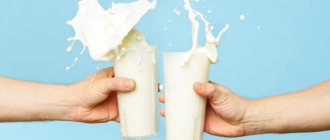Diet therapy occupies an important place in the complex treatment of diabetes mellitus.
A balanced diet helps achieve two goals at once: achieving normal body weight and normalizing blood sugar levels.
The importance of weight loss in diabetic patients is based on the fact that excess body weight leads to a decrease in tissue sensitivity to insulin, which is restored after weight loss.
Berries and fruits play a very important role in shaping the diet of people with diabetes. But when choosing this healthy treat, it is important to consider their glycemic index.
What are the benefits of low GI foods?
After a sharp increase in blood glucose levels, the body strives to restore balance and activates the pancreas. The hormone insulin is produced which transports the resulting glucose into the cells. But if nutrients are supplied in excess of the need, the excess is sent “to reserves” - stored as fat. After 1-2 hours, when all the glucose has been processed, hunger is felt again.
Foods with a low glycemic index are digested slowly, and glucose enters the blood gradually. Therefore, no additional insulin is produced. Result: a long, stable feeling of fullness; fat reserves are not replenished.
The predominance of white bread, potatoes, sugar, corn in the diet with minimal physical activity leads to obesity. At the same time, people who consume the same amount of calories in the form of vegetables, lean meat and seafood maintain their normal weight.
In addition to the glycemic index, the percentage of carbohydrates in each type of product is also taken into account. For example, carrots are quickly digested, but they contain only 29% carbohydrates. And in refined sugar - 100%. By multiplying these two indicators, you get the glycemic load (GL): this indicator accurately characterizes how quickly a food is digested and how much it affects weight gain. Therefore, it is not worth giving up all foods with a high GI, but it would be wise to limit those that have a high GI and percentage of carbohydrates. These are products made from white flour and sweets.
It is important not to torture yourself with hunger, but to include in your diet as much food as possible with a low glycemic index and a low percentage of carbohydrates. This scheme will help maintain the health of the pancreas and form correct eating habits.
Low glycemic index foods
A distinctive feature of low GI foods is the gradual release of energy to the body, which is why the carbohydrates of such foods are called slow.
Almost all fruits, grains and nuts have a low glycemic index. In the clinical treatment of obesity, a diet based on low-glycemic foods shows good results. A diet based on foods with low glycemic content is necessary for diabetics and when losing weight. Meat, fish, and poultry are low-carbohydrate foods, so their GI is close to zero, as is the GL. Low glycemic index foods - full table
| Product | GI |
| Canned pineapple | 50 |
| Pineapple (fresh) | 50 |
| Pineapple juice (no sugar) | 50 |
| Bananas are yellow (with black dots) | 50 |
| Sweet potato, cassava, sweet potato | 50 |
| Lingonberry* juice without sugar | 50 |
| Jam, jam (with sugar) | 50 |
| Biscuits (whole flour, no sugar) | 50 |
| Cereal bars (sugar free) | 50 |
| Dried figs | 50 |
| Kiwi* | 50 |
| Cranberry* juice without sugar | 50 |
| Crab sticks | 50 |
| Lychee (fresh fruit) | 50 |
| Pasta (from durum wheat) | 50 |
| Mango (fresh fruit) | 50 |
| Muesli (no sugar) | 50 |
| Peaches (canned in syrup with sugar) | 50 |
| Jam (with sugar) | 50 |
| Basmati rice | 50 |
| Unpeeled rice, whole | 50 |
| Boiled spaghetti from whole wheat flour | 50 |
| Jerusalem artichoke, earthen pear | 50 |
| Quinoa bread (approximately 65% quinoa) | 50 |
| Persimmon | 50 |
| Chayote (puree) | 50 |
| Blueberry juice sour (no sugar) | 50 |
| Apple juice (no sugar) | 50 |
| Orange juice (no sugar) | 45 |
| Bananas are yellow (no black spots) | 45 |
| Bananas-vegetables raw | 45 |
| Cowberry* | 45 |
| Whole grain bulgur | 45 |
| Vermicelli (thin) | 45 |
| Grapes (fresh) | 45 |
| Grapefruit juice (no sugar) | 45 |
| Jam (no sugar) | 45 |
| Canned green peas | 45 |
| Cranberry* | 45 |
| Coconut, coconut flakes | 45 |
| Bulgur grains (boiled) | 45 |
| Whole grain couscous (whole grain semolina) | 45 |
| Montignac muesli without sugar, caramel and honey | 45 |
| German bread Pumpernickel | 45 |
| Sugar-free jam (concentrated grape juice) | 45 |
| Bulgur wheat (boiled) whole grain | 45 |
| Spelled wheat (whole grain flour, bread) | 45 |
| Basmati rice, whole, unpeeled | 45 |
| Rye (whole flour, bread) | 45 |
| Tomato sauce (with sugar) | 45 |
| Whole grain toast (no sugar) | 45 |
| Kamut bread | 45 |
| Whole grains (no sugar) | 45 |
| Peanut butter (no sugar) | 40 |
| Beans (dry) | 40 |
| Buckwheat | 40 |
| Kamut (whole grain) | 40 |
| Yeast-free lavash made from whole grain flour | 40 |
| Lactose | 40 |
| Quince marmalade (no sugar) | 40 |
| Whole wheat matzo | 40 |
| Coconut milk | 40 |
| Carrot juice (no sugar) | 40 |
| Carrots (boiled)* | 40 |
| Quinoa flour | 40 |
| German bread Pumpernickel brand Montignac | 40 |
| Oats (whole) | 40 |
| Oatmeal (raw) | 40 |
| Whole grain spelled | 40 |
| Polvorón (whole wheat flour, no sugar) Spanish dessert | 40 |
| Sesame paste (tahini), ground sesame paste | 40 |
| Boiled durum wheat spaghetti “al diente” (boiled for 5 minutes) | 40 |
| Boiled spaghetti from whole wheat flour “al diente” (boiled for 5 minutes) | 40 |
| Dry cider | 40 |
| Canned red and brown beans (in cans) | 40 |
| Bean falafel | 40 |
| Bread, 100% whole grain with natural yeast | 40 |
| Chicory (drink) | 40 |
| Frozen fruit sorbet (no sugar) | 40 |
| Figs (fresh fruit); Tsabr (Indian fig) fresh fruit | 35 |
| Fresh apricots | 35 |
| Fresh quince | 35 |
| Amaranth | 35 |
| Anona, cherimoya | 35 |
| Fresh oranges | 35 |
| White beans with meat | 35 |
| Mustard | 35 |
| Fresh pomegranate | 35 |
| Yeast | 35 |
| Fresh green peas | 35 |
| Sunflower grains | 35 |
| Figs (fresh fruit) | 35 |
| Yogurt ** | 35 |
| Quinoa | 35 |
| Coconut flour | 35 |
| Celery root (raw) | 35 |
| Corn (wild) | 35 |
| Sesame (grains) | 35 |
| Chinese noodles, vermicelli (from durum wheat) | 35 |
| Flax-seed | 35 |
| Poppy (grain) | 35 |
| White almonds (shelled, sugar-free nut butter) | 35 |
| Chickpea (chickpea) flour | 35 |
| Nectarine (fresh fruit) | 35 |
| Peaches (fresh fruit) | 35 |
| Brewer's yeast | 35 |
| Dried tomatoes | 35 |
| Wild rice/black rice | 35 |
| Sunflower seeds | 35 |
| Creamy ice cream with fructose | 35 |
| Plums (fresh fruit) | 35 |
| Soy yogurt (flavored) | 35 |
| Dry tomatoes | 35 |
| Tomato juice | 35 |
| Tomato sauce (no sugar) | 35 |
| Chickpeas (canned) | 35 |
| Falafel (chickpea, chickpea) | 35 |
| White beans | 35 |
| Beans red, variegated, black | 35 |
| Black beans | 35 |
| Sprouted grain bread | 35 |
| Wasa crispbread (24% dietary fiber) | 35 |
| Prunes | 35 |
| Dried apples | 35 |
| Apple (fresh fruit) | 35 |
| Applesauce (no sugar) | 35 |
| Whole grain bread | 34 |
| Fresh grapefruit | 30 |
| Fresh pears | 30 |
| Chinese soy noodles or vermicelli | 30 |
| Dried apricots | 30 |
| Tangerines | 30 |
| Marmalade (no sugar) | 30 |
| Almond milk (commercially produced) | 30 |
| Miso paste | 30 |
| Milk** (any fat content) | 30 |
| Powdered/fresh milk** | 30 |
| Carrots (raw) | 30 |
| Oat milk (raw) | 30 |
| Pomelo | 30 |
| Fresh tomatoes | 30 |
| Turnip (raw) | 30 |
| Beetroot (raw) | 30 |
| Cottage cheese ** | 30 |
| Chickpeas (chickpeas) | 30 |
| Lentils | 30 |
| Yellow lentils | 30 |
| Brown lentils | 30 |
| Maltitol (maltitol) | 26 |
| Peanuts (sugar-free nut butter) | 25 |
| Dry crushed peas | 25 |
| Blackberry | 25 |
| Fresh strawberries | 25 |
| Fresh strawberries | 25 |
| Hazelnuts (sugar-free nut butter) | 25 |
| Raspberries (fresh) | 25 |
| Mung beans, mung beans, golden beans | 25 |
| Whole almonds (nut butter without sugar) | 25 |
| Pumpkin seeds | 25 |
| Red currants, gooseberries | 25 |
| Hummus (chickpea puree) | 25 |
| Cherries | 25 |
| Blueberry | 25 |
| Green lentils | 25 |
| Dark chocolate / dark chocolate (> 70% cocoa) | 25 |
| Whole grain peeled barley | 25 |
| Barley groats (hulled crushed barley grains) | 25 |
| Barbados cherry | 20 |
| Cocoa powder (no sugar) | 20 |
| Lemon juice (no sugar) | 20 |
| Almond flour | 20 |
| Hazelnut flour | 20 |
| Bamboo shoots | 20 |
| Ratatouille | 20 |
| Soy cream | 20 |
| Soy yogurt (unflavored) | 20 |
| Tamari sauce (no sugar) | 20 |
| Fructose | 20 |
| Dark chocolate / dark chocolate (> 85% cocoa) | 20 |
| Agave (concentrate) | 15 |
| Agar-agar | 15 |
| Brussels sprouts | 15 |
| Walnuts, dry fruit | 15 |
| Champignon mushrooms | 15 |
| Green bean | 15 |
| Carob bean powder | 15 |
| Grain shoots | 15 |
| Zucchini | 15 |
| Sauerkraut | 15 |
| Chinese cabbage | 15 |
| Cauliflower | 15 |
| Pine nuts | 15 |
| Red bell pepper | 15 |
| Carob | 15 |
| Hazelnuts | 15 |
| Onion | 15 |
| Shallot | 15 |
| Lupine | 15 |
| Olives | 15 |
| cucumbers | 15 |
| Olives | 15 |
| Bran (wheat, oats...) | 15 |
| Bell pepper, chili, hot | 15 |
| Pesto (herb sauce) | 15 |
| Wheat (sprouted) | 15 |
| Radish | 15 |
| Wheat sprouts, sprouted grains | 15 |
| Leaf lettuce | 15 |
| White beets (leaves) | 15 |
| Black currant | 15 |
| Tempeh, Tempe, Tempeh (from soybeans) | 15 |
| Tofu | 15 |
| Dill | 15 |
| Physalis | 15 |
| Pistachios | 15 |
| Hazelnut | 15 |
| Shallots, Ascalonian onions, shallots | 15 |
| Champignon | 15 |
| Endive | 15 |
| Spice, seasoning (parsley, basil, oregano, cinnamon, vanilla, etc.) | 5 |
| Cancers | 5 |
| Vinegar | 5 |
| Seafood (oysters, mussels, shrimp, etc.) | 0 |
| Soy sauce (no sweeteners) | 0 |
In general, eat more foods with a low glycemic index. This will provide your body with enough energy throughout the day (don’t forget about eating well and consuming enough calories).
Sugar addiction
The release of glucose into the blood causes a surge of energy, and at the same time a slight euphoria. Therefore, foods with a glycemic index below 50, which do not cause this effect, seem less tasty. But the mechanism of receiving joy in exchange for food leads to sugar addiction. A person eats a new sandwich or another candy when the effect of the previous one ends; at the same time skips a full lunch or dinner.
To avoid sugar addiction, it is recommended to build your diet mainly on foods with low and medium GI; they should make up at least 80% of your daily calorie intake. Of course, you can eat both sweet and starchy foods, but you should do this once and in the first half of the day. Now nutritionists (doctors who study food and its nutritional properties) refute the theory of the “carbohydrate window”: a lack of carbohydrates that supposedly occurs after a workout. Therefore, eating chocolate bars after the gym is actually just as harmful as before.
Fruits for diabetes
Fruits contain a lot of fiber. This digestion is what lowers the GI level. However, some fruits are very sweet, so when choosing a diet for a diabetic, it is important to take into account the GI of each fruit separately. These indicators are summarized in tables that can be easily found in free sources or asked from an endocrinologist.
High Glycemic Index Fruits Chart
| Name | GI |
| A pineapple | 66 |
| Raisin | 65 |
| Dates | 110 |
| Watermelon | 72 |
| Banana | 60 |
| Persimmon | 55 |
| Melon | 60 |
| Mango | 55 |
Fruits with a high glycemic index are sweet and juicy. This figure is high for children’s favorite watermelon and melon, some exotic and dried fruits - persimmons, dates.
Pineapple is good for weight loss, but not good for diabetes as it has a high GI.
Pineapple is used for weight loss. This fruit is low in calories and contains fat-burning bromelain. It is rich in B vitamins, contains minerals and macroelements. Eating pineapple helps with arthritis, bronchitis, and nervous system disorders. But despite all the benefits, people with diabetes do not eat it: the glycemic index of pineapple is 65 units.
Persimmon is rich in microelements (Mg, Ca, P, K, I) and a group of vitamins E, C, PP, A. The glycemic index of persimmon is 55 - this is the average value, and it also contains a lot of sugar. Therefore, it is better for a diabetic not to eat this fruit every day. Persimmon helps with nervous disorders, heart disease and oncology. It is better for people with gastrointestinal problems to exclude persimmon from their diet.
Low glycemic index
| Name | GI |
| Apricots | 20 |
| Oranges | 35 |
| Grape | 40 |
| Pomegranate | 35 |
| Grapefruit | 25 |
| Pear | 34 |
| Quince | 35 |
| Figs | 35 |
| Dried apricots | 30 |
| Lemon | 20 |
| Kiwi | 40 |
| Nectarine | 35 |
| Mandarin | 40 |
| Avocado | 10 |
| Peaches | 30 |
| Plum | 22 |
| Apple | 30 |
| Prunes | 25 |
The glycemic index of kiwi is low. Kiwi is a storehouse of vitamin C, it is healthy and affordable. They like to eat the fruit in winter, when seasonal fruits have lost most of their beneficial vitamins and macroelements. One piece of this green fruit every 2-3 days normalizes the functioning of the heart muscle, increases a person’s resistance to viruses and stress, and is used to prevent bleeding, rheumatism and malignant tumors.
A tasty and healthy pomegranate that can be eaten by everyone.
The glycemic index of pomegranate and grapefruit is equally low - 25 units. Both fruits are low in calories and have unique properties:
- Pomegranate is able to restore hemoglobin levels and have a beneficial effect on hematopoiesis, being a natural antibiotic.
- Regular consumption of grapefruit reduces the level of “bad” cholesterol.
There is no need to give up your favorite pear, fresh peach, apple or nectarine - these are fruits with a low glycemic index. They can be used raw, added to casseroles, pancakes and other healthy dishes. Dried pear has a high GI, but it can be prepared for compotes. The use of baked apples in food is also recommended for diabetes.
Low GI is not a panacea
Unfortunately, the glycemic index table is not the ultimate truth.
- GI can vary among different types of the same product: for example, for pasta it is from 40 to 60, depending on the variety.
- The food index varies depending on the combination of products with each other. For example, in a stew it is not equal to the arithmetic mean for vegetables.
Therefore, you need to monitor your GI without fanaticism, remember that the numbers in the table are approximate, and do not forget to control the total calorie content of what you eat.
Sweets whose GI was calculated
In fact, the glycemic index is calculated for a small list of foods. This is done by a special group of scientists. In Australia, for example, manufacturers specifically pay for an expensive GI calculation in order to put this index on the packaging of their goods. Therefore, for many foods there is only an average glycemic index.
Popular Products:
- Fructose
- Chocolate
- Honey
The glycemic index of fructose is 20 . This means that any fructose-based dessert that does not contain other carbohydrate ingredients will have approximately the same GI value.
For example, jelly. The index of fruits and berries is in the table of low values. And if you decide to make jelly with strawberries, then its GI will be about 30. Fructose has an indicator of 20, strawberries - 32. To be on the safe side, we take into account the upper indicator of the ingredients. It is also worth considering the ripeness of the strawberries. The sweeter and riper it is, the higher its GI is likely to be.
The glycemic index of dark chocolate is 25 . We are talking about almost unsweetened chocolate with a cocoa content of more than 80%. The less cocoa, the more GI. The GI of the sweet's dairy counterpart is 70. Read about the benefits of chocolate for diabetes here.
Glycemic index of honey – from 30 GI . The older the honey, the higher the rate. The fact is that young honey contains a lot of fructose, which has a low index. Over time, honey sugars, that is, fructose turns into sucrose. Fully candied honey has a GI of 80, almost the same as sugar and glucose. Read about honey for diabetes.
On the diabetic menu
Examples of baked goods with the addition of fructose, which will appeal not only to patients with diabetes, but also to their relatives.
Quick cottage cheese buns
To prepare the dough you need:
- a glass of cottage cheese;
- egg;
- 1 tbsp. fructose;
- a pinch of salt;
- 0.5 tsp soda, which must be extinguished with vinegar;
- a glass of buckwheat or barley flour.
Mix cottage cheese, beaten egg, fructose and salt. Add slaked soda and mix everything. Add flour in small portions. Buns can be formed into any shape and size.
Examples of use of the substance
The sweet monosaccharide is used in several areas:
- Cooking – as sweeteners for making confectionery and juices.
- Sports – for quick recovery of the body during periods of excessive physical activity and intense training.
- Medicine – to eliminate the symptoms of ethyl alcohol poisoning. Intravenous administration increases the rate of alcohol elimination, minimizing the risk of possible side effects.

Significant physical activity – indications for fructose consumption
Functions of organic compounds
Carbohydrates perform certain functions as part of the cells and tissues of organisms:
- protection - some plants have protective devices, the main material of which is carbohydrates;
- structure – compounds become the main part of the cell walls of fungi and plants;
- plastics - are part of molecules that have a complex structure and are involved in the synthesis of energy, molecular compounds that ensure the preservation and transmission of genetic information;
- energy – “processing” of carbohydrate leads to the formation of energy and water;
- reserve - participation in the accumulation of nutrients needed by the body;
- osmosis – regulation of blood osmotic pressure;
- sensation - are part of a significant number of receptors, helping to carry out their function.
Excessive consumption
The “hepatic” route of entry of the monosaccharide into the body increases the load directly on the organ and systems as a whole. The result may be a decrease in the cells' ability to respond to insulin.
Possible complications include:
- Hyperuricemia is an increase in the amount of uric acid in the bloodstream, which can cause the development of gout.
- Hypertension and other diseases accompanied by increased blood pressure.
- Fatty liver disease of non-alcoholic origin.
- Obesity and infertility due to the development of resistance of body cells to the hormone that controls the flow of lipids.
- Lack of control over satiety - the threshold between the feeling of hunger and satiety changes the boundaries.
- Diseases of the cardiovascular system that result from excess amounts of cholesterol and fats in the bloodstream.
- The appearance of a non-insulin-dependent form of diabetes in a healthy person due to a decrease in the sensitivity of cells to the pancreatic hormone.
Important! Eating fruits, sweet fruits and vegetables is not associated with possible risks. We are talking about the excessive use of fructose isolated by synthesis.
